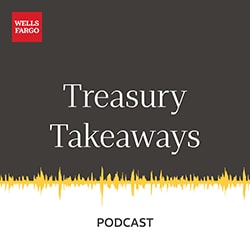>>Jonathon Traer-Clark:
Hello and welcome to another episode of Treasury Takeaways. My name is Jonathan Traer-Clark. I'm a managing director at Wells Fargo, and today I'm absolutely delighted to be joined by Joe Hussey, who is one of our Payables and Receivables Product Executives in our Treasury Management Business. Welcome, Joe. It's great to have you.
>>Joe Hussey:
Thank you. Glad to be here. I'm Joe Hussey and I'm the payables and receivables executive here at Wells Fargo. I'm also the current chair of the Nacha board. Nacha oversees the ACH network in the US. In both roles, I see our job to make payments seamless, fast, and efficient from a same day ACH to instant payment. We seek to drive innovation to solve the needs of our clients in a safe and secure process. Nacha has a similar focus, and the board has been dedicated to focusing on speed of payment, data delivery and fraud protection initiatives over the last few years. As we continue to see payments transition and innovation occur around those payments, I assume and expect there will be a lot more innovation ahead of us yet to come.
>>Jonathon Traer-Clark:
Fantastic. Perhaps you'd like to tell our listeners a few of the highlights of the things that you do, both in terms of Wells Fargo, but also how you represent, if you like, the wider Treasury community.
>>Joe Hussey:
Yeah. Thank you. So from a Wells Fargo perspective, I look at our role as delivering products out to the clients, both the traditional products as well as the innovative products and the emerging products that are continuing to come on board in the payments space. As I look back, 10 or 15 years where we were thinking that everything was still paper for the most part. We had minimal electronic and digitization out there, too. If you spring forward, we've seen a lot of changes and we've seen a tremendous amount of innovation occur in the space. But yet we still know we have about 13 billion checks out there that we're still processing every year. So the one step forward, two step backs somehow feels like it applies. But when you look at it across, you know, the last 20 years or so, you know, we've taken 20, 20 billion checks out of the industry. We just are stuck on the last piece. The other component that you ask about was, how do we see what we do today, and how do we deliver that for Wells Fargo as a firm and then broader in the industry? Probably the industry has become one of the more critical perspectives, because if there's one thing we've learned is we need this ability for a transaction to be easy across multiple platforms. There are certainly across multiple networks. And as we continue to innovate, that ability for a payment to move seamlessly between two providers and even between two clients is incredibly important for us. And everything we do, we try to focus on how quickly and efficiently can we move that payment.
>>Jonathon Traer-Clark:
I know you've used the term payments continuum, and when I've spoken to you in the past, but you also talked about different networks, different types of payments. I mean, forgive me, it's surprising to think that if you like moving money around transactions representing the movement of money around. Is it so difficult? Can you just kind of give us a few clues as to why that is the case today?
>>Joe Hussey:
I like the term the continuum of payments because what a payment is today, it may not be tomorrow. And the way we look at how we evolve payments, especially when we're working with our treasury groups across the multiple industries, moving a health care payment across the industry can be very different than moving a simple cell phone bill or a utility bill across it. So when I talk to multiple clients and we talk about what is the payment structure, what is the payment architecture, this continuum of - it depends on what you're trying to pay. If you're a large retailer, a lot of your receipts are going to go through the credit card industry. But yet when you turn it around, you have to buy goods and services, and those are going to go across a completely different rail, which may be ACH card, virtual card or wire. And so as I look across at what I've tried to get clients to open up with is what are your biggest pain points and what would you like for us to solve for you? I've never been really one of those, “if you build it, they will come”, I'd prefer to go find a problem and solve the problem for a client, because in our industry, if you solve for one client, you've probably solved for multiple vendors or counterparties. If you can do that, you now have an ability to say, it worked over here. Does the same thing apply to you as well? So regardless of the industry, you're touching base in, you can actually say this works for health care. Does it work for the auto dealerships? Does it work for aerospace? And you can find the commonality within those industries.
>>Jonathon Traer-Clark:
Thank you. But when we talk about payments, which I think is typically how the industry has a conversation, the other side of a payment, of course, is a receipt or receivable. Right. So I am pleased that you have both hats. That's great. And obviously for our clients and perhaps. The industry. You know, the receiving of money in that reconciliation is as important, right?
>>Joe Hussey:
Definitely. So I think you mentioned earlier, I also sit as chairman of Nacha. And the way the industry is evolved, I'll say over the last probably ten, ten, 15 years is we used to focus a lot on payroll and moving payments out. Right. What we really have focused on now is how do we make that receivable as seamless as possible? And when you look at what we do here, moving the money is often the less important piece. The most important piece is that I just bought something from you, but you need to be credited for my payments. So the fact that you have the money sitting in your organization, but this vendor hasn't been credited with it, is a problem. But also, if you look at the amount of emerging innovation that's occurring within our industry, the fintechs and everyone that we partnered with are now working together to try to simplify. How do we reconcile your payment to my invoice? As quickly as we can and move that into a working capital for the client.
>>Jonathon Traer-Clark:
I'm so pleased you kind of went into that space about the reconciliation, right? I mean, I can remember a time when field size limit was a massive constraint, within transactional information as it cost around the systems because, frankly, there was a real dollar charge or cost to it. And because of the size of mainframes and all the other sorts of systems, whereas nowadays, obviously infrastructure and telecommunications and indeed just technology as a whole has evolved enormously. So presumably, and not wanting to put words into your mouth, but that should make the process of reconciliation much easier, particularly with AI.
>>Joe Hussey:
Yes. Let's talk about just field size. All of us can harken back to the Y2K events, where we were all arguing over the two digit or four digit year, right. Where we've evolved from there, though, is with the new file formats, we've added more and more information to our transactions that go through. We even have transactions today that aren't really monetary transactions. They are just simply information transactions that we're passing back and forth, whether it be within Swift, within wire, within ACH, within the card networks, the more information we can pass, the better the reconciliation is. And then I'll add to that, the better the reconciliation is, the better the customer experience is. Whether you are a corporate client or a consumer client working with your biller, the ability to have that information out there and visible on both sides of the transaction is really one of those changes that we've seen that has come into effect, and it started slowly. We added a few more data fields here. We added a few more characters over here. But what it's evolved to is I can almost now literally send a PDF for every single transaction if I chose to. Now, there are some architects out there who just cringed when I said it, because we don't need that on all of our transactions, but that is the ability we have now is we have data, we have image, and we have monetary all sitting within a framework that allows us to keep that package together, that enables then the final client to say, I can reconcile this, and I can also move the money much more quickly into my balances.
>>Jonathon Traer-Clark:
So interesting there. We talked a lot about, I'm going to call it client experience. It's becoming much simpler for the transactions to represent not just value transfer but information transfer, which obviously facilitates a much better end to end user and customer experience and probably business experience overall. But all of this requires not just investment from our side as an industry, to make the mechanics work and operate better, but also for the customers, the end users. In your experience, what sort of makes a client sort of feel compelled to kind of either update their systems or think about modifying the way they transmit information to us, and how might they go about it? The best way.
>>Joe Hussey:
I'm going to start with the latter half of that question about how do they go about it, and then we'll talk about why do they do it. Only because I think everyone gets afraid of, how do I go about it before I actually answer, why am I ready to do this? Or why do I need to do it? My perspective on how to go about it. And I talked to several larger groups, if you're waiting on that final solution, that will be the end all, be all, you'll probably be waiting a long time. And as we look at the evolution of our applications and then the evolution of all of the changes that are out there, a lot of the hesitancy, I think at least when I came into banking, candidly, in the 80s, was, you know, you wanted to go with one of the big powerhouses that were out there because you just knew it was going to be safe for you to do that. There was also this theory that you don't want to be the first on any application, because you're debugging it for a client at the current pace of change. Look at where that has changed. And then think about if I wait, what have I lost in waiting? And if I'm waiting to change, has one of my competitors going to leapfrog me because they went ahead and made a bet on an on an application? So that's my, what do I think about the change and how do I think about the change? Answer. Because I think as an organization, both banking and corporate and government, you have to answer that second question. Am I willing to make the change now? Why do I make the change, which is what you asked first. I think it's fairly straightforward. When you look at where are your consumers going and where are your vendors going or the people that you're trying to pay? Are the people buying products from you, even in corporate to corporate, that has changed tremendously, where we now go online to look at our invoices, even if you're a corporate to corporate, if I am buying from a large consumer supply company, I probably know every day what's on my shelves and what do I need to purchase. If my system can't keep up with that, or if, as I'm building out or looking at what are the new products coming to market and I have a consumer website, what is more frustrating for us as a consumer than to order something, only to get an email saying it's not available later, right? Expectations have been set on the consumer side that if it's not available, it says that when I pull it up, right. That's just the way the marketplace’s work. Why would my corporate applications not do the exact same thing? You and I know, the reason is because the corporate applications - with the plural - probably has multiple receivables sitting under it, payables sitting under it, inventory from mergers and acquisitions that now need to be combined. So the answer I always give, and especially when we're talking to clients thinking of what investments are important to them, the first thing you need to do is to make the corporate experience almost as seamless as what it is when I go home and I try to do a consumer transaction. Because regardless of what we do in our day jobs, our experiences are usually formed on what we get to do on our end, our laptops and our mobile phones at home.
>>Jonathon Traer-Clark:
I love the way you put that right. I mean, the analogy I use when I try to describe these things to, you know, how non-financial folk is when you go to buy a car, you want to understand how it feels to drive. You trust, if you like, that, the mechanics and the operations will work. And so that defines your experience. But it also defines not just your experience at the point of purchase, but also for the lifetime of it. So the same analogy here in the financial services sector, of course, is that the consumer experience, to your point, should mirror the one at home. And yes, the underlying mechanics are important, but how the engineers, if you like, of the organization, build those, that's where they should be focused. Whilst the overall user experience is much more one of just facilitation of transfer.
>>Joe Hussey:
I had an interesting dialog with a group of analysts that were coming into the firm one time, and we were talking about the in-office experience versus the at-home experience, and I realized that my in-office experience in ‘85 was more technologically advanced in the office than I was at home with probably my VCR, Betamax, or whatever I had back then, right? Today, if you flip that around, the tools we have at home and our ability to go have double monitors and triple monitors and everything else we can have at home, may be completely different than what we get when we step into our work environment, which is prescribed by our companies. Right. And I thought that was an interesting analogy that I've used with clients before. As we think about both hiring and next generation of Treasury managers coming in, all of those things come together to how do you entice the right people and as well, how does your working environment mirror what I can do at home? Can I, you know, can I make it simple?
>>Jonathon Traer-Clark:
I love that analogy. It's so true, right? My HP 12 C sitting on my desk at home is not the same as my working for it, wasn't it? Back in the days when we were starting our careers, shall we say. It would be, remiss of us, obviously not to mention, particularly, I think even news this weekend about some data leak, shall we say, how should a client think about, I guess, fraud and security and might I think to some extent it's a continual chasing mechanism. People are trying to keep up with it. But I mean, what's your perspective? What advice would you give our listeners?
>>Joe Hussey:
It's a funny topic when it comes up with clients, because if you haven't dealt with fraud and security, you probably look at it as a complete sunk cost that you don't have a return on. If you've dealt with the fallout of a security breach or even fraud on your own bank accounts, you quickly see it as an investment and a very preventative tactic, right? The problem we have is, is there is no one right answer to fraud and security, right? There are multiple ways you can tackle each of those fraud in and of itself, will, always evolve to the most sophisticated criminal, if you will, because, you know, everyone's in business to get paid including our criminals. Right. And they continue to up the bar, unfortunately. When we look at things like business, email, compromise, there are tools you can use without a doubt. But those are procedural controls that in many cases need to be applied within a Treasury organization that often are overlooked because of legitimate other higher priorities until something occurs. Right? And then everyone says, wait a minute, how did we let this occur? You know, you move to best practices, and that happens. If you go to a conference, you don't go to a conference anymore without multiple sessions available on fraud and security practices. I think that is really upped the industry overall. So we have stopped a significant amount of it, but there are just more people out there trying to perpetrate against the industry today. Without a doubt, the industry itself has also evolved. I spoke about Nacha before. We probably spend well over a third of our time talking about fraud and within the industry and the tools that we can use. You've seen rule changes that we've put out there that tried to layer a standard approach to everyone, because when you're in a counterparty market, everyone is exposed at the most vulnerable level some time. So we worked on that. If you take it one step further and you say, okay, what can I do to prevent fraud within my company? Every client needs to ask themselves that because it's probably different for every company. I'll close with the security part of everything we do has become so paramount to the trust of our client. And so when I started this answer, I mentioned the fact that it's never important until it's important, losing the trust of your client. And I won't name examples, but all of you had a couple that probably just popped into your head. Once that trust is lost, building back that trust is incredibly difficult, right? And we've all spent in our organizations, you know, some over 100 years building that trust, then gaining it back once you've lost it, because of a security or any other interjection of fraud into the system, puts the whole industry in a problem. So I think we have to look at both incredibly important. Does everyone need to spend 40% of their time on it? If you haven't, you will.
>>Jonathon Traer-Clark:
So there's an awful lot of information there. And I just also want to connect back to some of the things that you said at the beginning, because you also said transactions don't just represent monetary transfer, they can represent information. And one of the things that occurred to me was, with the advent of if we like more paper to electronic, there's also the opportunity there to use information services like account validation and whatnot to try and ensure or at least give a how shall we put this a greater degree of confidence. Either the recipient or the beneficiary is who you think it is, and therefore, you know you can feel comfortable that your business is operating in a secure manner as possible. I'm guessing from your perspective, do you see the emergence of more solutions like that, giving clients multiple layers of defense?
>>Joe Hussey:
Without a doubt. When you look at it, account validation and it can mean a lot of different things to different people, doesn't mean that this account is good. Doesn't mean the account is open. The way I look at it, and the way we have tried to talk about it, is use a risk-based approach to it. I think when you move up the continuum, though, if this is a new vendor that is setting up for the first time or two, someone's calling in and saying, hey, I had to get a new account number. And the worst thing to have happen is they call and say, I had fraud on my account, I need a new account. Well, they're the ones frauding you because they didn't get a new account, right? That's the time where there's clearly a need to do an additional level of due diligence on that account number, because the volume and the value you're about to send across that is significant and could represent a significant, charge off to the company. The solutions out in the industry today are varied. And, you know, it goes from a very basic which have a nominal price to them, to the more complex that have a more sophisticated.
>>Jonathon Traer-Clark:
The point is, if you have a breach, you have a breach. And it's probably a failure of multiple layers, control systems, possibly people, possibly a genuine mistake, quite often a genuine mistake, and usually some element of technology as well. So the challenge the Treasury function has is that as a concentrator of how should we say financial assets, or is the allocation of capital engine, as I like to call it. You know, that responsibility isn't just about collecting, it's also about dispersing it too, which kind of brings us back to your original point. You know, it's customer experience led.
And as the name of the podcast suggests, what are our takeaways from this? Well, I think there's three of them. I'm going to start, as always with customer experience. Right. One of our responsibilities is to make sure that, as we said, our clients and customers really do experience the very best of the capabilities that we have to offer. But in order to do that, we need to also be very welcoming and think a lot about changing innovation. And I think, Joe, you said it best. It's about having conversations with others. It's about listening and learning, being open to new opportunities, but also taking a measure of that experience and understanding what's worked well in the past and what may still be appropriate today. Which brings me neatly onto the third point I would make, which I think is around fraud and security. And that is always going to be a continuum in the way that we have to operate and run our businesses. We must be aware that. We have a responsibility, to operate and disperse and collect, if you like, the moneys and the capital that flows through our ecosystems. So those are my three takeaways for today. And again, Joe, thanks ever so much for your time today.
>>Joe Hussey:
Thank you.
>>Jonathon Traer-Clark (Disclosures):
Global Treasury Management products and services are provided by Wells Fargo Bank, N.A. Wells Fargo Bank, N.A. is a bank affiliate of Wells Fargo & Company. Wells Fargo Bank, N.A. is not liable or responsible for obligations of its affiliates. Deposits held in non-U.S. branches, subsidiaries or affiliates are not FDIC or CDIC insured. Deposit products offered by Wells Fargo Bank, N.A. Member FDIC.

 Sign On
Sign On  The world of finance continues to evolve at a staggering pace, impacting nearly every aspect of the way treasurers do business. Market events and technological advances have transformed the discipline, resulting in both opportunities and challenges. Today’s treasurer must remain agile, not only optimizing working capital management for the organization, but also serving as a valued advisor to the management team.
The world of finance continues to evolve at a staggering pace, impacting nearly every aspect of the way treasurers do business. Market events and technological advances have transformed the discipline, resulting in both opportunities and challenges. Today’s treasurer must remain agile, not only optimizing working capital management for the organization, but also serving as a valued advisor to the management team. 



